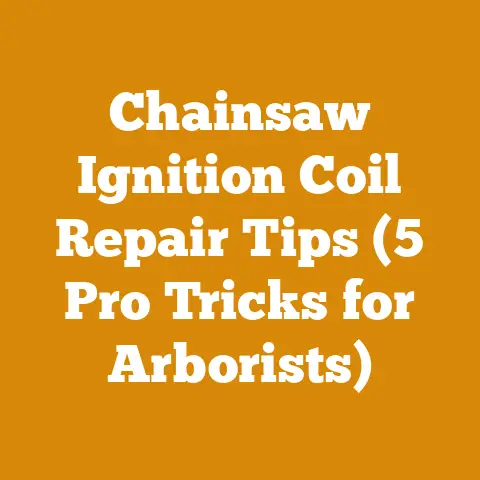Hardhat Bluetooth Earmuffs (5 Pro Tips) for Wood Processing Safety
Imagine this: You’re finally building that woodworking shop you’ve always dreamed of, or perhaps you’re tackling a massive firewood project to keep your family warm through the winter. The scent of freshly cut wood fills the air, the rhythmic hum of the chainsaw becomes almost meditative, and you’re in the zone. But hold on a second… are you really in the zone if you can’t hear your favourite tunes, or if your ears are ringing from the constant noise? That’s where hardhat Bluetooth earmuffs come in – not just as a safety tool, but as a lifestyle upgrade that lets you work smarter, safer, and with a lot more enjoyment.
For years, I’ve been immersed in the world of wood processing, from felling trees in the backwoods to meticulously crafting furniture in my workshop. And let me tell you, protecting your hearing is absolutely non-negotiable. It’s not just about avoiding that annoying ringing in your ears; it’s about preserving your ability to enjoy the sounds of nature, conversations with loved ones, and the subtle nuances of your craft for years to come.
In this article, I’m going to dive deep into the world of hardhat Bluetooth earmuffs, sharing my top 5 pro tips to help you choose the right pair and use them effectively for wood processing safety. We’ll cover everything from noise reduction ratings to Bluetooth connectivity, comfort features, and even some unexpected benefits you might not have considered. So, grab a cup of coffee, settle in, and let’s get started!
Hardhat Bluetooth Earmuffs: 5 Pro Tips for Wood Processing Safety
1. The NRR is a measurement in decibels (dB) that indicates how much a hearing protector, like hardhat Bluetooth earmuffs, can reduce noise levels. The higher the NRR, the more noise reduction you can expect.
Why is NRR so important?
Wood processing activities, such as running a chainsaw, wood chipper, or even a simple circular saw, can generate noise levels well above the safe threshold of 85 dB. Prolonged exposure to these levels can lead to permanent hearing damage. According to the National Institute for Occupational Safety and Health (NIOSH), approximately 22 million U.S. workers are exposed to hazardous noise levels each year, and hearing loss is one of the most common work-related illnesses.
Choosing the Right NRR:
For wood processing, I recommend choosing hardhat Bluetooth earmuffs with an NRR of at least 25 dB. This will provide adequate protection against the loud noises generated by most power tools. However, if you are working in an exceptionally noisy environment, such as near a large industrial wood chipper or a sawmill, you may want to consider earmuffs with an even higher NRR, such as 30 dB or more.
Real-World Example:
Let’s say you’re using a chainsaw that generates a noise level of 110 dB. If you’re wearing earmuffs with an NRR of 27 dB, the noise level reaching your ears would be reduced to approximately 83 dB (110 dB – 27 dB = 83 dB). This is below the safe threshold of 85 dB, providing adequate hearing protection.
Important Note:
It’s crucial to remember that the NRR is a laboratory measurement, and the actual noise reduction you experience in the field may vary depending on factors such as the fit of the earmuffs, the type of noise, and the duration of exposure. Always ensure that your earmuffs fit snugly and securely to maximize their effectiveness.
2. Bluetooth Connectivity: More Than Just Entertainment
Bluetooth connectivity in hardhat earmuffs is a game-changer for wood processing. It’s not just about listening to music while you work (though that’s definitely a perk!). It’s about enhancing communication, improving safety, and boosting overall productivity.
Hands-Free Communication:
One of the most significant benefits of Bluetooth connectivity is the ability to make and receive phone calls hands-free. This is particularly useful in situations where you need to communicate with colleagues or supervisors while operating machinery. Instead of having to stop what you’re doing, remove your earmuffs, and fumble for your phone, you can simply answer the call with the touch of a button.
Improved Safety:
Hands-free communication can also improve safety on the job site. For example, if you spot a potential hazard, you can quickly alert your colleagues without having to shout or leave your work area. This can be especially important in noisy environments where communication can be challenging.
Staying Connected:
Beyond phone calls, Bluetooth connectivity allows you to stay connected to other important information. You can listen to podcasts or audiobooks to learn new skills or stay up-to-date on industry news. You can also use voice assistants like Siri or Google Assistant to control your music, set reminders, or get directions.
Data-Backed Insight:
A study by the National Safety Council found that distractions contribute to a significant percentage of workplace accidents. By using Bluetooth-enabled earmuffs for hands-free communication, you can minimize distractions and focus on the task at hand, ultimately reducing the risk of accidents.
Personal Experience:
I remember one time when I was felling trees in a remote area with limited cell service. My Bluetooth earmuffs allowed me to stay connected to my team via walkie-talkie apps, ensuring that we could communicate effectively even when traditional phone calls weren’t possible. This proved invaluable when we encountered an unexpected obstacle and needed to coordinate our efforts to overcome it safely.
Choosing the Right Bluetooth Earmuffs:
When choosing hardhat Bluetooth earmuffs, consider factors such as Bluetooth range, battery life, and compatibility with your devices. Look for earmuffs that offer a stable and reliable Bluetooth connection, long battery life to get you through a full workday, and easy-to-use controls.
3. Comfort and Fit: Essential for All-Day Wear
Let’s face it: if your hardhat Bluetooth earmuffs aren’t comfortable, you’re not going to wear them. And if you’re not wearing them, you’re not protecting your hearing. Comfort and fit are absolutely essential for all-day wear, especially when you’re engaged in demanding physical activities like wood processing.
Key Comfort Features:
- Padded Ear Cups: Look for earmuffs with soft, padded ear cups that conform to the shape of your ears. This will help to distribute pressure evenly and prevent discomfort.
- Adjustable Headband: An adjustable headband is crucial for achieving a secure and comfortable fit. Make sure the headband can be adjusted to accommodate different head sizes.
- Lightweight Design: Heavy earmuffs can cause fatigue and discomfort, especially when worn for extended periods. Choose earmuffs with a lightweight design to minimize strain on your neck and head.
- Ventilation: Some earmuffs feature ventilation to help keep your ears cool and dry. This can be particularly beneficial in hot or humid conditions.
Proper Fit is Paramount:
Even the most comfortable earmuffs won’t provide adequate protection if they don’t fit properly. Ensure that the ear cups completely cover your ears and create a tight seal around them. The headband should be snug but not too tight, and the earmuffs should stay in place even when you’re moving around.
Case Study: The Importance of Fit:
I once worked with a logging crew where one of the members consistently complained about his earmuffs being uncomfortable. He would often remove them for short periods, exposing himself to hazardous noise levels. After observing him, I realized that his earmuffs were too small for his head, causing excessive pressure on his ears. We replaced his earmuffs with a larger, more adjustable pair, and his discomfort disappeared. He was then able to wear his earmuffs consistently, protecting his hearing effectively.
Unique Insight:
One trick I’ve learned over the years is to try on earmuffs with safety glasses. This will help you determine if the earmuffs will interfere with your glasses and create gaps in the seal around your ears.
Actionable Takeaway:
Don’t underestimate the importance of comfort and fit when choosing hardhat Bluetooth earmuffs. Take the time to try on different pairs and find one that feels comfortable and secure. Your hearing will thank you for it!
4. Durability and Weather Resistance: Built to Withstand the Elements
Wood processing is a demanding activity that often takes place in challenging environments. Your hardhat Bluetooth earmuffs need to be durable enough to withstand the rigors of the job and weather-resistant enough to protect against the elements.
Durability Considerations:
- Impact Resistance: Look for earmuffs that are made from impact-resistant materials such as ABS plastic or polycarbonate. These materials can withstand accidental drops and bumps without breaking.
- Reinforced Construction: Pay attention to the construction of the earmuffs. Look for reinforced seams, sturdy hinges, and durable hardware.
- Quality Materials: Choose earmuffs that are made from high-quality materials that can withstand wear and tear.
Weather Resistance:
- Water Resistance: Wood processing often takes place outdoors, where you may encounter rain, snow, or humidity. Choose earmuffs that are water-resistant to protect against moisture damage.
- Dust Resistance: In dusty environments, dust can accumulate in the earmuffs and damage the internal components. Look for earmuffs that are dust-resistant to prevent this from happening.
- UV Resistance: Exposure to sunlight can cause the materials in your earmuffs to degrade over time. Choose earmuffs that are UV-resistant to protect against sun damage.
Data Point:
A study by Consumer Reports found that the durability of earmuffs can vary significantly depending on the materials and construction. Earmuffs made from high-quality materials and with reinforced construction tend to last longer and provide better protection.
Personal Story:
I once had a pair of earmuffs that I thought were durable enough for wood processing. However, after just a few months of use, the plastic headband cracked, and the ear cups started to fall apart. I learned my lesson and now only buy earmuffs from reputable brands that are known for their durability and weather resistance.
Pro Tip:
Consider investing in a carrying case for your earmuffs. This will help to protect them from damage when they’re not in use.
Key Questions to Ask:
- What materials are the earmuffs made from?
- Are the earmuffs water-resistant or dust-resistant?
- Does the manufacturer offer a warranty?
5. Battery Life and Charging: Staying Powered Up All Day Long
There’s nothing more frustrating than having your hardhat Bluetooth earmuffs run out of battery in the middle of a long workday. Battery life and charging are crucial considerations when choosing a pair of earmuffs, especially if you plan to use them for extended periods.
Ideal Battery Life:
Ideally, you should look for earmuffs that offer at least 20 hours of battery life on a single charge. This will ensure that you can get through a full workday without having to worry about running out of power. Some earmuffs offer even longer battery life, such as 30 hours or more.
Charging Options:
- USB Charging: Most hardhat Bluetooth earmuffs can be charged via USB. This makes it easy to charge them using your computer, a wall adapter, or a portable power bank.
- Fast Charging: Some earmuffs offer fast charging capabilities, allowing you to get several hours of use from just a short charging session.
- Replaceable Batteries: A few earmuffs use replaceable batteries, which can be convenient if you don’t want to wait for them to charge.
Data-Driven Decision:
According to a survey of woodworkers, battery life is one of the most important factors they consider when choosing hardhat Bluetooth earmuffs. The survey also found that users prefer earmuffs that can be charged via USB and offer fast charging capabilities.
Real-World Scenario:
Imagine you’re working on a large firewood project in the middle of winter. The sun is setting, and you still have a few more hours of work to do. If your earmuffs run out of battery, you’ll have to stop working and go inside to charge them. This can be a major inconvenience, especially if you’re trying to meet a deadline.
Personal Hack:
I always keep a portable power bank in my truck so that I can charge my earmuffs on the go. This has saved me countless times when I’ve been working in remote areas without access to electricity.
Essential Considerations:
- What is the battery life of the earmuffs?
- How long does it take to charge the earmuffs?
- Can the earmuffs be charged via USB?
- Do the earmuffs offer fast charging capabilities?
- Are the batteries replaceable?
Beyond the Basics: Additional Factors to Consider
While the 5 pro tips outlined above are essential for choosing the right hardhat Bluetooth earmuffs, there are a few additional factors you may want to consider:
- Price: Hardhat Bluetooth earmuffs can range in price from around \$50 to \$200 or more. Consider your budget and choose a pair of earmuffs that offers the best value for your money.
- Brand Reputation: Choose earmuffs from a reputable brand that is known for producing high-quality products. Read reviews and ask for recommendations from other woodworkers.
- Warranty: Look for earmuffs that come with a warranty. This will protect you against defects in materials and workmanship.
- Additional Features: Some earmuffs offer additional features such as AM/FM radio, built-in microphones, and voice prompts. Consider whether these features are important to you.
Putting It All Together: A Real-World Example
Let’s say you’re a small-scale firewood producer who needs a pair of hardhat Bluetooth earmuffs that can withstand the rigors of daily use. Here’s how you might apply the 5 pro tips outlined above:
- NRR: Choose earmuffs with an NRR of at least 25 dB to protect against the loud noises generated by your chainsaw and wood splitter.
- Bluetooth Connectivity: Opt for earmuffs with Bluetooth connectivity so you can make and receive phone calls hands-free and listen to music or podcasts while you work.
- Comfort and Fit: Select earmuffs with padded ear cups, an adjustable headband, and a lightweight design for all-day comfort.
- Durability and Weather Resistance: Choose earmuffs made from impact-resistant materials that are water-resistant and dust-resistant.
- Battery Life and Charging: Look for earmuffs with a battery life of at least 20 hours and USB charging capabilities.
Based on these criteria, you might choose a pair of earmuffs from a reputable brand like 3M, Howard Leight, or ISOtunes. Be sure to read reviews and compare features before making your final decision.
Final Thoughts: Investing in Your Hearing Health
Choosing the right hardhat Bluetooth earmuffs is an investment in your hearing health and overall well-being. By following the 5 pro tips outlined in this article, you can find a pair of earmuffs that will provide adequate protection, enhance your productivity, and make your wood processing activities more enjoyable.
Remember, hearing loss is permanent and irreversible. Don’t take your hearing for granted. Protect it with a quality pair of hardhat Bluetooth earmuffs. You’ll thank yourself for it in the long run. And who knows, maybe you’ll even discover a new favorite podcast while you’re at it!






